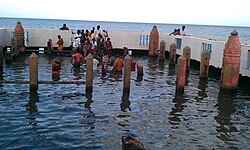| This article is an orphan, as no other articles link to it. Please introduce links to this page from related articles; try the Find link tool for suggestions. (September 2017) |
| Navapashanam Temple | |
|---|---|
 | |
| Religion | |
| Affiliation | Hinduism |
| District | Ramanathapuram |
| Deity | Navagrahas |
| Location | |
| Location | Devipattinam |
| State | Tamil Nadu |
| Country | India |
 | |
| Geographic coordinates | 9°28′53″N 78°53′55″E / 9.48139°N 78.89861°E / 9.48139; 78.89861 |
Navapashanam temple is a Hindu temple dedicated to Navagrahas, the nine planetary deities, located in Devipattinam, the South Indian state of Tamil Nadu. It is a Hindu pilgrimage centre located in the Bay of Bengal. As per Hindu legend, the nine mud images of the planetary deities, have been believed to have built by Rama, an avatar of Vishnu.
The temple is a famous pilgrimage centre in the region where pilgrims perform rites for their forefathers. It is also a part of popular tourist circuit in the region along with the Ramanathaswamy Temple at Rameswaram and Adi Jagannatha Perumal Temple at Thiruppullani. The temple was originally maintained and administered by the Ramanathapuram Samasthanam Devasthanam under the Hereditary Trustee of the Queen of Ramanathapuram until now and controlled by the Department of HR & CE, Government of Tamil Nadu.
Legend

As per Hindu legend, Ravana, a king, obtained boons from Brahma that he should be killed by any celestial deity or gods. To slay the demon, Vishnu took a human avatar Rama. Ravana came to the forest where Rama and Sita were staying incognito and abducted her. Rama was trying to build a bridge to Lanka to relieve his wife Sita from Ashokavana, where Ravana held her hostage. The bridge was proposed to be built from Dhanushkodi, the nearest point to reach Lanka. Rama started doing pooja seeking favours from Hindu god Ganesha, as is done first during any Hindu religious worship. The place where he did the worship is believed to be the Vinayagar temple at Uppur. The second step for Hindu worship ritual is the Navagraha pooja, worshipping the nine planetary deities, which was done at Navapashanam. Rama is believed to have installed the Navagrahas with his own hands with the clay from the place.
Architecture
Navapashanam is located in Devipattinam, a town located 66 km (41 mi) on the East Coast Road. The nine image of the planetary deities is located in a matrix arrangement in the Bay of Bengal. There is an entrance arch on the shores and a pathway 100 yd (91 m) long leads to the sanctum. There is a pathway and four stepways leading to the waters in the four cardinal directions. There are nine stones planted in square plan in cardinal directions with the stone at the center indicating the Sun surrounded by eight other planets. These stones are believed to have been installed by Ram. The village also houses a temple for Devi following the legend of killing the buffalo demon Mahishasura and hence the place is called Devipattinam.
Festivals
The temple was originally maintained and administered by the Sivaganga Devasthanam until 2012, when it was taken up by the Hindu Religious and Endowment Board of the Government of Tamil Nadu. The actual handover happened in December 2015 after court intervention. The temple is open from 4:30 a.m. to 6:30 pm on all days. The major festivals celebrated in the temple are the ten-day Aadi Amavasai, the full moon day on the Tamil month of Aadi (June - July) and Thai amavasai (New moon day in January) during the Tamil month of Thai (January - February). During these days, there are close to one lakh pilgrims who visit the place. The place is commonly visited by pilgrims doing their rites for their forefathers. It is also a part of popular tourist circuit in the region along with the Ramanathaswamy Temple at Rameswaram and Adi Jagannatha Perumal Temple at Thiruppullani. The practise of offering nine different type of grains specific to each of the nine planets is commonly followed in the temple. Unlike other South Indian temples, where people are not allowed to touch the presiding deities, pilgrims can do their own worship on the images.
References
- V., Meena. Temples in South India. Kanniyakumari: Harikumar Arts. p. 13.
- ^ "Sri Navapashana temple". Dinamalar. 2014. Retrieved 10 November 2015.
- Nair, Shantha N. (2009). The Lord Shiva. Pustak Mahal. p. 180. ISBN 9788122310399.
- ^ D.J., Walter Scott (1 December 2015). "'Navapashanam Temple' comes under HR and CE department". The Hindu. Retrieved 23 January 2021.
- Illustrated Guide to the South Indian Railway (1926). Illustrated Guide to the South Indian Railway (Incorporated in England): Including the Tanjore District Board, Pondicherry, Peralam-Karaikkal, Travancore State, Cochin State, Coimbatore District Board, Tinnevelly-Tiruchendur, and the Nilgiri Railways. Asian Educational Services. pp. 108–9. ISBN 9788120618893.
- Select Shrines of Sri Rama. Little Flower Company. 1964. p. 69.
- Palanithurai, Ganapathy (2008). Change Makers at Grassroots: Local Governance in Action. Concept Publishing Company. p. 24. ISBN 9788180694714.
- Palanithurai, Ganapathy (2008). Change Makers at Grassroots: Local Governance in Action. Concept Publishing Company. ISBN 9788180694714.
- "Thousands pay obeisance on Thai amavasya". The Hindu. 4 February 2019. Retrieved 23 January 2021.
- Bajpai, R.S. (2002). The Splendours And Dimensions Of Yoga 2 Vols. Set. Atlantic Publishers & Distributors. p. 484. ISBN 9788171569649.
External links
| Navagraha | ||
|---|---|---|